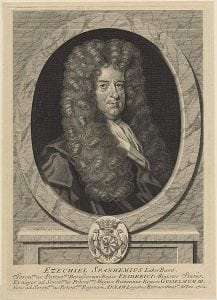There are strange pig tails in the midnight sun
From men who moil for hog’s stones
The science trails have their secret tales
That would make monstrous piglets groan;
The English nights have seen queer sights
But the queerest they ever did see
Was that marge on the note of Stephen Gray
Concerned with porcine impersonation.(1)
Pig tales occasionally show up in the Sloane Correspondence, and they are inevitably crackling good fun. But what do pigs have to do with the history of science? A while back, Samantha Sandassie (@medhistorian) wrote a fascinating post on the role of pigs in early modern medical history: besides providing a useful addition to one’s diet, pigs were often the subject of wondrous stories. By the eighteenth century, they were also the subject of Royal Society interests: classifying strange objects from animal bodies, understanding the development of fetal deformities, and analysing the composition of food stuffs.
John Morton, a naturalist who described fossils and wrote The Natural History of Northamptonshire, wrote to Hans Sloane about an extraordinary hog’s stone in April 1703. Morton thanked Sloane for his friendship and promised his service in return; this included sharing his work in progress on fossils. The description of the hog’s stone was, presumably, a taster for Sloane, but Morton also mentioned the possibility of sending it as a gift to the Royal Society. Sloane’s patronage was desirable, but even more so was attracting the interest of the Royal Society, and Morton was successful in both.
On the 30th of November 1703, Morton—nominated by Sloane’s rival, John Woodward—was accepted as a Fellow of the Royal Society. By June 1704, Morton had gifted the stone to the Royal Society after they had favourably received his account of it. A seemingly small offering, perhaps, but one that helped to establish a correspondence that continued for over a decade.
Sloane’s family members also sent him objects of interest. On Sloane’s birthday in 1711, his stepson-in-law John Fuller sent “a Couple of Monstrous Piggs, one of them was farrowed alive the other dead, the sow had six Piggs beside, all of them as they should be”. A quick perusal of the Philosophical Transactions of the Royal Society reveals that monsters remained a source of fascination to the Society throughout the eighteenth century.
Disability and deformity were frequently explained in terms of the influence of maternal imagination: that the pregnant woman either had cravings or had been subjected to extreme emotions, either of which could shape an unborn child. (See, for example, Philip Wilson’s article on maternal imagination and disability.) Fuller’s piglets would have been especially intriguing, given that only two of the sow’s litter had been monstrous. What might the study of deformity in animals mean for the medical understanding of human reproduction? And why, moreover, were traits only passed on to some offspring? Food for thought: a fine gift, indeed, for Sloane!
But the strangest pig tale in the correspondence is from Stephen Gray, who was better known for his work on electricity than porcine expertise. Even so, in the summer of 1700, Sloane requested that Gray send further details about the fat of some pork that he had sent to the Royal Society. Gray denied all knowledge of the pork sample, insisting that either someone had the same name or was impersonating him. A fairly random occurrence that raises so many tantalizing questions: was there another Stephen Gray who was a pork expert? Was this a practical joke? And if so, was it intended for the Society or Gray? And what was its point? In any case, the Society clearly wanted to find out more about the chemical composition of pigs.
These three little pig gifts may seem like small tokens, but reflect the roles of patronage, reputation and curiosity in early eighteenth-century medical and scientific knowledge. Now, if only the joke or insult behind Gray’s impersonation could be deciphered: any thoughts?
[1] With apologies to Robert Service and my father, whose favourite poem is Service’s The Cremation of Sam McGee. I’d started this post in time for Father’s Day post, but was otherwise occupied at the time and unable to finish it.
Image: Eight pigs on a meadow near a wallow with a thatched barn in the background. After E. Crété after W. Kuhnert. Credit: Wellcome Library, London.


